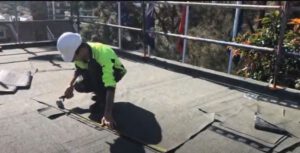Can I install a roof membrane to improve waterproofing in my Australian home?
 A leaky roof can lead to significant damage to your Australian home, including structural issues, mold growth, and damage to your belongings. Installing a roof membrane is a practical solution to improve waterproofing and protect your home from water ingress. This article discusses the benefits of roof membranes, their types, and the installation process.
A leaky roof can lead to significant damage to your Australian home, including structural issues, mold growth, and damage to your belongings. Installing a roof membrane is a practical solution to improve waterproofing and protect your home from water ingress. This article discusses the benefits of roof membranes, their types, and the installation process.
The Importance of Roof Waterproofing
Roof waterproofing is a crucial aspect of home maintenance, as it prevents water from seeping into your home and causing damage. A well-maintained, waterproofed roof can prevent costly repairs, extend the life of your roof, and protect your home’s structural integrity.
Understanding Roof Membranes
A roof membrane is a continuous, flexible, and durable layer of material that is applied to the roof surface to create a watertight barrier. Roof membranes can be used on various roof types, including flat roofs, low-slope roofs, and pitched roofs. They provide a long-lasting, effective solution to prevent water leaks and protect your home from water damage.
Types of Roof Membranes
There are several types of roof membranes available, each with its own set of advantages and disadvantages. The most common types include:
- Bituminous Membranes: Made from bitumen, a petroleum-based product, these membranes are highly durable and flexible. They are available as torch-on or self-adhesive sheets, making them easy to install. Bituminous membranes are a popular choice for flat and low-slope roofs.
- Liquid-Applied Membranes: These membranes are applied as a liquid that cures to form a seamless, waterproof layer. Liquid-applied membranes can be made from various materials, including polyurethane, acrylic, and silicone. They are ideal for complex roof shapes and structures, as they can be applied to any surface.
- Single-Ply Membranes: Made from synthetic materials like PVC, TPO, or EPDM, single-ply membranes are lightweight, flexible, and highly resistant to punctures and tears. They are typically installed using mechanical fasteners or adhesives and can be used on flat and low-slope roofs.
Roof Membrane Installation Process
The installation process for roof membranes varies depending on the type of membrane and the roof’s condition and complexity. Generally, the process involves the following steps:
- Roof Inspection and Preparation: A professional roofer will inspect your roof to determine its condition, identify any issues that need to be addressed, and recommend the most suitable membrane type. The roof surface must be clean, dry, and free from any debris before membrane installation.
- Priming and Substrate Preparation: Depending on the membrane type, the roof surface may require priming or the application of a substrate material. This step ensures proper adhesion and a smooth surface for the membrane.
- Membrane Installation: The membrane is carefully laid out and secured to the roof surface. This process varies depending on the membrane type and may involve torching, adhesive, or mechanical fasteners.
- Sealing and Finishing: Once the membrane is in place, the seams and edges are sealed to create a watertight barrier. This may involve using seam tape, liquid sealants, or additional membrane material.
- Inspection and Maintenance: After installation, the roof membrane should be inspected regularly and maintained to ensure its longevity and effectiveness.
Advantages of Roof Membranes
 Roof membranes offer several benefits, including:
Roof membranes offer several benefits, including:
- Enhanced Waterproofing: The primary advantage of a roof membrane is its ability to provide a watertight barrier, preventing water from entering your home and causing damage.
- Durability and Longevity: High-quality roof membranes are resistant to UV rays, extreme temperatures, and harsh weather conditions, making them a long-lasting solution.
- Cost-Effective: While there is an initial investment, a roof membrane can save you money in the long run by preventing costly water damage and extending your roof’s life.
- Safety: Roof membranes provide additional traction and slip-resistance, making them a safe choice for roofs in areas that experience inclement weather.
- Lightweight: Because they are thinner and lighter than other materials, roof membranes can reduce the load on your home’s structure, helping to preserve its integrity.
Energy Efficiency: Roof membranes are highly reflective, which helps them to keep your home cool in the summer and reduce energy costs.
Conclusion
Installing a roof membrane is a practical and effective way to improve the waterproofing of your Australian home. By understanding the different types of roof membranes and their installation process, homeowners can make an informed decision about the best solution for their specific needs. Always consult with a professional roofer to ensure proper installation and maximum protection for your home.

Links
- Why Choose
- About Us
- Case Studies
- Our Services
- Contact
Services
- Petroleum and Gas
- Industrial Construction
- Chemical Research
- Mechanical Engineering
- Power Energies
© 2021 By Magic Page Plugin
- Home
- About
- Services
- Contact
